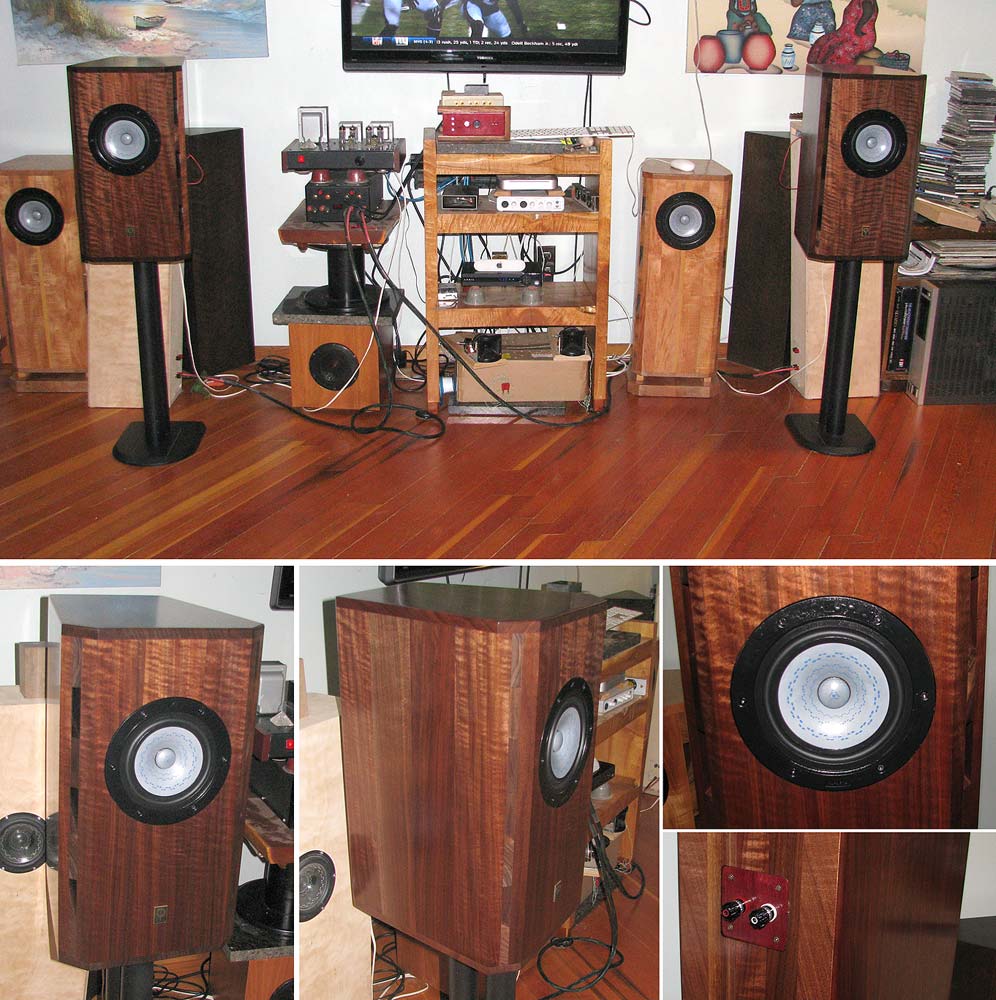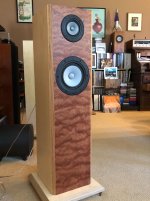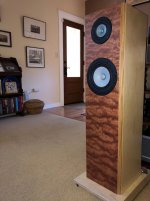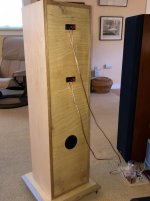Just finished the simple two-way design with Alpair 12PW + Alpair 7PeN.
These were built to spec except for a rear-facing port. The 12s have about 400 hrs of gradual break-in and the 7s have about 150 after receiving them from Dave (I believe they had several hundred hrs on his bench before shipment).
Used 3/4" baltic birch and a holey brace between baffle and back in the lower woofer chamber. I doubled the 3/8" home depot sourced denim ultratouch on all interior surfaces.
The crossover design is first order low pass and second order high pass at what seems to be (based on drivers' impedance) about 1.2khz and 1.4khz electrical respectively.
I'll be listening extensively over the next several days, but initial impressions are quite positive...the lows are quite low and wonderful and the top is incredibly revealing if just a bit bright on vocal s's.
When I'm finished building another pair featuring only the lower woofer chamber, adding two more 12's to the mix by stacking upside down on pictured full cabinets, I'll go with line level crossover and experiment with an A7.3m in MTM configuration.
Thanks Dave and Scott for the design and help!
Regards,
Mario
These were built to spec except for a rear-facing port. The 12s have about 400 hrs of gradual break-in and the 7s have about 150 after receiving them from Dave (I believe they had several hundred hrs on his bench before shipment).
Used 3/4" baltic birch and a holey brace between baffle and back in the lower woofer chamber. I doubled the 3/8" home depot sourced denim ultratouch on all interior surfaces.
The crossover design is first order low pass and second order high pass at what seems to be (based on drivers' impedance) about 1.2khz and 1.4khz electrical respectively.
I'll be listening extensively over the next several days, but initial impressions are quite positive...the lows are quite low and wonderful and the top is incredibly revealing if just a bit bright on vocal s's.
When I'm finished building another pair featuring only the lower woofer chamber, adding two more 12's to the mix by stacking upside down on pictured full cabinets, I'll go with line level crossover and experiment with an A7.3m in MTM configuration.
Thanks Dave and Scott for the design and help!
Regards,
Mario
Attachments
(I believe they had several hundred hrs on his bench before shipment).
More like 1,000. These need lot sof break-in.
dave
Really nice-looking veneer. Good job!
The two drivers seem to be pretty far from each other, considering the crossover frequency of 1.2KHz (~29cm wavelength). Is there a reason for having such a center-to-center distance?
The two drivers seem to be pretty far from each other, considering the crossover frequency of 1.2KHz (~29cm wavelength). Is there a reason for having such a center-to-center distance?
230mm.
So they fit. 😉 Crossover frequency is significantly below 1 wavelength separation & at this frequency, it's more or less a non-issue. Not for a speaker of this kind anyway.
So they fit. 😉 Crossover frequency is significantly below 1 wavelength separation & at this frequency, it's more or less a non-issue. Not for a speaker of this kind anyway.
Last edited:
The crossover design is first order low pass and second order high pass at what seems to be (based on drivers' impedance) about 1.2khz and 1.4khz electrical respectively.
Those coils look pretty big....Do you have any more info on the crossover? Seems like the A7 could go lower (also it seems to be spaced pretty far from the A12). What is your listening distance to the speaker?
As it is presently configured, do you think the quantity of bass is insufficient? Unless you listen loud, maybe padding the A7 is a simpler/easier approach.
Hi Folks,
As far a driver spacing, I did increase the space between the two by 3/8" in an effort to make equal MTM spacing when I put another "lower chamber" cabinet on top and upside down....they'll be another 3/4" of wood from the lower chamber cab. This is coming in a couple weeks...
I've listened extensively with two different amps over the past three days and really love this design. My take on the A12Pbw is that it's outstanding! No lack of bass whatsoever and pleasingly not "1 note base". It delivers the lows in spades yet has great punch and transients....voices really couldn't sound any better IMHO. I'm excited for addition of two more A12Pbw.
The highs are very very detailed. For acoustic music the A7P is an absolute winner of detail....I'm hearing subtleties I've never heard before.
On the other hand if one is enjoying pop, rock or any 90's era CD, a warm and tubby 300B amp is the way to go as it tames otherwise harsh highs from the A7P with these tunes. I was surprised by this as generally the 300B is not my go to.
I've found of the two amps I'm using, the FW SIT 2 is the best overall. Plenty of power for my purposes at a conservative 10w/ch and distortion of the second harmonic...maybe not quite as kind on nasty highs with the above mentioned music, but still the most enjoyable overall for good recordings.
See attached plans with crossover details.
Regards,
Mario
As far a driver spacing, I did increase the space between the two by 3/8" in an effort to make equal MTM spacing when I put another "lower chamber" cabinet on top and upside down....they'll be another 3/4" of wood from the lower chamber cab. This is coming in a couple weeks...
I've listened extensively with two different amps over the past three days and really love this design. My take on the A12Pbw is that it's outstanding! No lack of bass whatsoever and pleasingly not "1 note base". It delivers the lows in spades yet has great punch and transients....voices really couldn't sound any better IMHO. I'm excited for addition of two more A12Pbw.
The highs are very very detailed. For acoustic music the A7P is an absolute winner of detail....I'm hearing subtleties I've never heard before.
On the other hand if one is enjoying pop, rock or any 90's era CD, a warm and tubby 300B amp is the way to go as it tames otherwise harsh highs from the A7P with these tunes. I was surprised by this as generally the 300B is not my go to.
I've found of the two amps I'm using, the FW SIT 2 is the best overall. Plenty of power for my purposes at a conservative 10w/ch and distortion of the second harmonic...maybe not quite as kind on nasty highs with the above mentioned music, but still the most enjoyable overall for good recordings.
See attached plans with crossover details.
Regards,
Mario
Attachments
I'm listening in a large room (used to be a large two car garage that was basically two-car deep) but listening around 10ft away...the back of the space behind my couch is a pingpong table-cum-workbench.
And yes, I suppose the A7P can go quite a bit lower, but why not milk as much as possible from the A12Pbw as IMO it's a better driver.
And yes, I suppose the A7P can go quite a bit lower, but why not milk as much as possible from the A12Pbw as IMO it's a better driver.
More or less.
I've already addressed the spacing, it's well within 1 wavelength and at these frequencies, it's not an issue. More broadly, shunting a crossover as low as possible without other considerations is overly simplistic; there is a tendency to see a large mid-tweet and automatically assume that the lowest possible crossover frequency is somehow obligatory, or will offer the optimal solution. Not so. It depends on circumstance and what, specifically, you are doing. In this case, since we are not dealing with a limited range woofer, but two wideband drive units with very similar off-axis behaviour, crossing slightly higher provides more emitting area through the midband, improving overall power handling and lowering distortion without significantly affecting the polars. Moreover, since as a design it is deliberately intended to be simple and relatively inexpensive to build, it allowed a crossover with a reduced parts count: a lower crossover frequency would have required more, which given the sizes involved sees costs rapidly spiral.
I've already addressed the spacing, it's well within 1 wavelength and at these frequencies, it's not an issue. More broadly, shunting a crossover as low as possible without other considerations is overly simplistic; there is a tendency to see a large mid-tweet and automatically assume that the lowest possible crossover frequency is somehow obligatory, or will offer the optimal solution. Not so. It depends on circumstance and what, specifically, you are doing. In this case, since we are not dealing with a limited range woofer, but two wideband drive units with very similar off-axis behaviour, crossing slightly higher provides more emitting area through the midband, improving overall power handling and lowering distortion without significantly affecting the polars. Moreover, since as a design it is deliberately intended to be simple and relatively inexpensive to build, it allowed a crossover with a reduced parts count: a lower crossover frequency would have required more, which given the sizes involved sees costs rapidly spiral.
And yes, I suppose the A7P can go quite a bit lower, but why not milk as much as possible from the A12Pbw as IMO it's a better driver.
Hmm, seems like the A12bw can be crossed even higher, like 3kHz to 5kHz out of the "t-band", then you could use an A5 or (gasp!) dome tweeter for even greater dispersion.
Or drop the coil and just add a super-tweeter with cap like Fostex uses/recommends for their larger full-rangers. Sometimes less is more....
How does the A12 sound by itself without the coil?
How does the A12pw sound by itself without the coil?
We rather like it. And at least one client using them as a FR.

dave
Hmm, seems like the A12bw can be crossed even higher, like 3kHz to 5kHz out of the "t-band", then you could use an A5 or (gasp!) dome tweeter for even greater dispersion.
Or drop the coil and just add a super-tweeter with cap like Fostex uses/recommends for their larger full-rangers. Sometimes less is more....
Do carry on, if that is what you want to do. With this design, I didn't want to do it, because I had specific objects, some of which are indicated above. Note however that high crossover frequencies typically result in a less consistent polar response with direct radiators. The 12PW has very good off-axis performance for a driver of its size, but as frequency increases it does start to reduce, so crossing higher up to a driver with greater off-axis output results in a flare, affecting tonality.
As has been pointed out, A12pw is a very versatile driver. We use it below 250 Hz in our MTM WAW, Scott crosses were he does with his, taking greater advantage of th edynamics of the A12pw, it can be used as a standard midbass with a tweeter (and all the issues/advantages of crossing that high — i have some CSS RT2 i keep looking at), or even used by itself as a FR.
The A12pw does not get enuff love.
dave
The A12pw does not get enuff love.
dave
Update: The simple two ways were very well received at Burning Amp a couple weeks ago. They were driven by the Firstwatt SIT3 as well as the prototype Firstwatt F8. The preamp was a Firstwatt "B1T" (with a transformer for 9db gain).
The passive crossover were tweeked just a bit to suit my tastes and listening room. Rather than the 1R resistor before the 7p's cap/inductor, I used a 6.8R resistor and than strapped a 3.3uf cap across the resistor to bring back a little treble that the 6.8R resistor attenuated.
At home I also tried substituting the 7m for the 7p as I prefer the 7m on its own v the 7p on its own. However, I found that in this two way system I preferred the 7p that the design specifies...better blend between the two paper drivers.
...my favorite build yet....
Mario
The passive crossover were tweeked just a bit to suit my tastes and listening room. Rather than the 1R resistor before the 7p's cap/inductor, I used a 6.8R resistor and than strapped a 3.3uf cap across the resistor to bring back a little treble that the 6.8R resistor attenuated.
At home I also tried substituting the 7m for the 7p as I prefer the 7m on its own v the 7p on its own. However, I found that in this two way system I preferred the 7p that the design specifies...better blend between the two paper drivers.
...my favorite build yet....
Mario
Last edited:
somewhat, ok way off topic: the LP cover seen on bottom right of the pic is Jim Carroll (author of Basketball Dairies), a great poet/musician IMO who was a vocalist on a pretty well known album "Catholic Boy" in early 80's.
He had two more albums within in a few years later that didn't get traction but are very good: "Dry Dreams" and "I Write Your Name". Those and an album he did around '99 "Pools of Mercury" are really worth checking out.
He had two more albums within in a few years later that didn't get traction but are very good: "Dry Dreams" and "I Write Your Name". Those and an album he did around '99 "Pools of Mercury" are really worth checking out.
- Home
- Loudspeakers
- Full Range
- "a simple 2-way: Alpair12pw + Alpair7PeN




